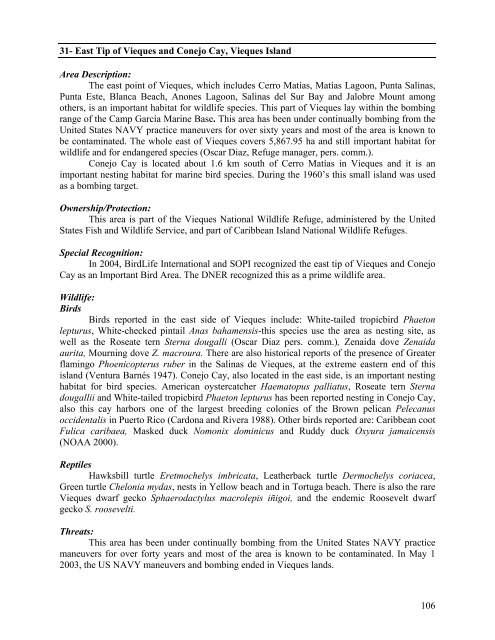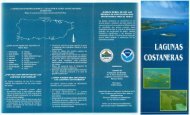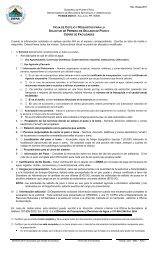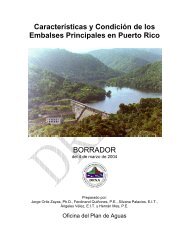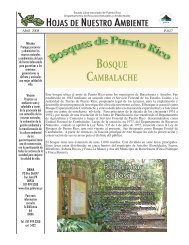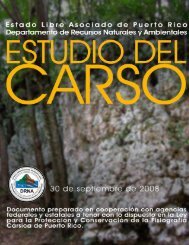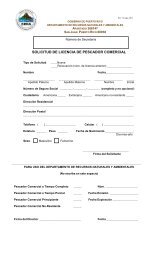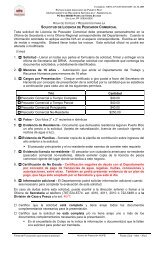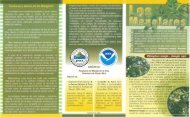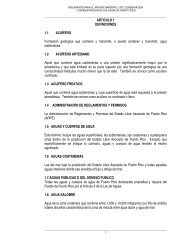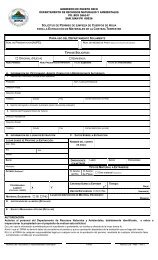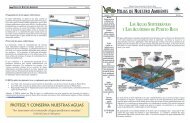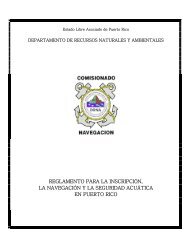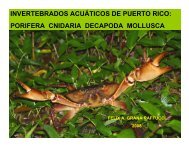Puerto Rico Critical Wildlife Areas - Puerto DRNA - Gobierno de ...
Puerto Rico Critical Wildlife Areas - Puerto DRNA - Gobierno de ...
Puerto Rico Critical Wildlife Areas - Puerto DRNA - Gobierno de ...
You also want an ePaper? Increase the reach of your titles
YUMPU automatically turns print PDFs into web optimized ePapers that Google loves.
31- East Tip of Vieques and Conejo Cay, Vieques Island<br />
Area Description:<br />
The east point of Vieques, which inclu<strong>de</strong>s Cerro Matías, Matías Lagoon, Punta Salinas,<br />
Punta Este, Blanca Beach, Anones Lagoon, Salinas <strong>de</strong>l Sur Bay and Jalobre Mount among<br />
others, is an important habitat for wildlife species. This part of Vieques lay within the bombing<br />
range of the Camp García Marine Base. This area has been un<strong>de</strong>r continually bombing from the<br />
United States NAVY practice maneuvers for over sixty years and most of the area is known to<br />
be contaminated. The whole east of Vieques covers 5,867.95 ha and still important habitat for<br />
wildlife and for endangered species (Oscar Diaz, Refuge manager, pers. comm.).<br />
Conejo Cay is located about 1.6 km south of Cerro Matías in Vieques and it is an<br />
important nesting habitat for marine bird species. During the 1960’s this small island was used<br />
as a bombing target.<br />
Ownership/Protection:<br />
This area is part of the Vieques National <strong>Wildlife</strong> Refuge, administered by the United<br />
States Fish and <strong>Wildlife</strong> Service, and part of Caribbean Island National <strong>Wildlife</strong> Refuges.<br />
Special Recognition:<br />
In 2004, BirdLife International and SOPI recognized the east tip of Vieques and Conejo<br />
Cay as an Important Bird Area. The DNER recognized this as a prime wildlife area.<br />
<strong>Wildlife</strong>:<br />
Birds<br />
Birds reported in the east si<strong>de</strong> of Vieques inclu<strong>de</strong>: White-tailed tropicbird Phaeton<br />
lepturus, White-checked pintail Anas bahamensis-this species use the area as nesting site, as<br />
well as the Roseate tern Sterna dougalli (Oscar Diaz pers. comm.), Zenaida dove Zenaida<br />
aurita, Mourning dove Z. macroura. There are also historical reports of the presence of Greater<br />
flamingo Phoenicopterus ruber in the Salinas <strong>de</strong> Vieques, at the extreme eastern end of this<br />
island (Ventura Barnés 1947). Conejo Cay, also located in the east si<strong>de</strong>, is an important nesting<br />
habitat for bird species. American oystercatcher Haematopus palliatus, Roseate tern Sterna<br />
dougallii and White-tailed tropicbird Phaeton lepturus has been reported nesting in Conejo Cay,<br />
also this cay harbors one of the largest breeding colonies of the Brown pelican Pelecanus<br />
occi<strong>de</strong>ntalis in <strong>Puerto</strong> <strong>Rico</strong> (Cardona and Rivera 1988). Other birds reported are: Caribbean coot<br />
Fulica caribaea, Masked duck Nomonix dominicus and Ruddy duck Oxyura jamaicensis<br />
(NOAA 2000).<br />
Reptiles<br />
Hawksbill turtle Eretmochelys imbricata, Leatherback turtle Dermochelys coriacea,<br />
Green turtle Chelonia mydas, nests in Yellow beach and in Tortuga beach. There is also the rare<br />
Vieques dwarf gecko Sphaerodactylus macrolepis iñigoi, and the en<strong>de</strong>mic Roosevelt dwarf<br />
gecko S. roosevelti.<br />
Threats:<br />
This area has been un<strong>de</strong>r continually bombing from the United States NAVY practice<br />
maneuvers for over forty years and most of the area is known to be contaminated. In May 1<br />
2003, the US NAVY maneuvers and bombing en<strong>de</strong>d in Vieques lands.<br />
106


